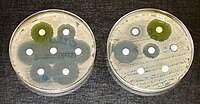
Photo from wikipedia
BACKGROUND This cross-sectional study assesses cytokine levels in peri-implant crevicular fluid (PICF)/gingival crevicular fluid (GCF) and a selection of subgingival/submucosal plaque bacteria from clinically healthy or diseased sites in the… Click to show full abstract
BACKGROUND This cross-sectional study assesses cytokine levels in peri-implant crevicular fluid (PICF)/gingival crevicular fluid (GCF) and a selection of subgingival/submucosal plaque bacteria from clinically healthy or diseased sites in the same individuals. METHODS Samples from 97 implants/teeth (58 implants [19 healthy, 20 mucositis, 19 peri-implantitis] and 39 natural teeth [19 healthy, 12 gingivitis, eight periodontitis] in 15 systemically healthy patients were investigated by immunoassay and real-time polymerase chain reaction. Samples were obtained first, with probing depth, clinical attachment level, bleeding on probing, plaque index scores, and keratinized tissue width then recorded. Data were analyzed by Wilcoxon, Mann-Whitney U, and permutation tests on dependent, independent, and mixed dependent and independent samples and Spearman correlation. RESULTS Interleukin (IL)-1β levels were significantly higher in PICF samples of healthy implants than in GCF samples of healthy teeth (P = 0.003), and soluble receptor activator of nuclear factor-κB ligand (sRANKL) concentrations were significantly higher in the gingivitis than the mucositis group (P = 0.004). Biomarker levels were similar in peri-implantitis and periodontitis groups (P >0.05). Actinomyces naeslundi and Streptococcus oralis levels were significantly higher in the healthy implant group than in healthy teeth (P <0.05). Prevotella intermedia and Treponema denticola (Td) levels were lower in the mucositis group than the gingivitis group (P <0.05). Prevotella oralis and S. oralis levels were significantly higher in the periodontitis group (P <0.05), and Td levels were significantly higher in the peri-implantitis group (P <0.05). CONCLUSION There were many similarities but, crucially, some differences in biomarker levels (IL-1β and sRANKL) and bacterial species between peri-implant and periodontal sites in the same individuals, suggesting similar pathogenic mechanisms.
Journal Title: Journal of Periodontology
Year Published: 2017
Link to full text (if available)
Share on Social Media: Sign Up to like & get
recommendations!